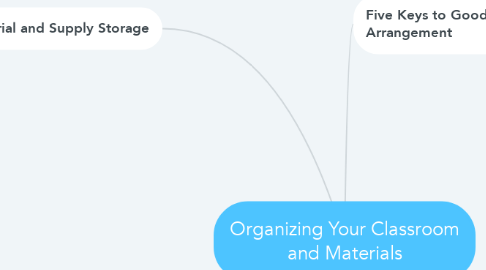
1. Five Keys to Good Room Arrangement
1.1. 1. Rooms should be consistent with a teacher's instructional goals. Desks should be arranged how the teacher wants to instruct the lesson either in whole groups or smaller cluster of desks. Regardless, of how the desks are arranged, all the students need to see the instructional display of the teacher.
1.2. 2. Places that are high traffic areas should be separated from the rest of the classroom. These high traffic areas include the pencil sharpener or trash can. Placing these areas away from the other students will alleviate some distractions.
1.3. 3. Teachers need to be able to see all the students easily. Clear lines of sight for the instructional areas, the teacher desks, and student desk is important.
1.4. 4. Keep materials that are used regularly in an accessible spot. Having to stop and locate materials will cause the students to lose interests and create unnecessary distractions.
1.5. 5. Every student should be able to see any whole-class presentations without having to move their desk or turn around. Teachers should sit in their student's desk to make sure they are seeing the instruction without difficulties.
2. Suggestions for Arranging Your Classroom
2.1. Wall and Ceiling Space
2.1.1. Displays in the classroom should include the classroom rules, a calendar, and daily activities. Useful strategies on different subjects can be displayed on walls. A display can be created to keep track of the students location. Materials should not violate in safety or fire codes. Decorations and posters should be age appropriate for the classroom.
2.2. Floor Space
2.2.1. A teacher needs to identify where he/she will be giving instruction and arrange the desks around that space. Creating a template of the classroom will cut down on the shuffling of desks. Keep high-traffic areas clear. Arrange desks in order to be able to walk easily among the students.
2.3. Small-Group Instruction Areas
2.3.1. Select an area where small groups can meet away from the other students. Computers should be placed in a position for the teacher to see the screen. The teacher desk should be away from the students to provide privacy when you are working one-on-one with a student. Whatever the furniture or equipment, always keep in mind line of sight with the students. Bookshelves should be out of the way and not hinder the view of the students. Some centers to incorporate in the classroom include math, science discovery, art, or dramatic play. Centers should be separated and the locations needs to be considered. For example, if the area is loud, place that center away from other students in order not to disturb others. Plants can add a personal touch to the room but check and see that other students are not allergic to them.
